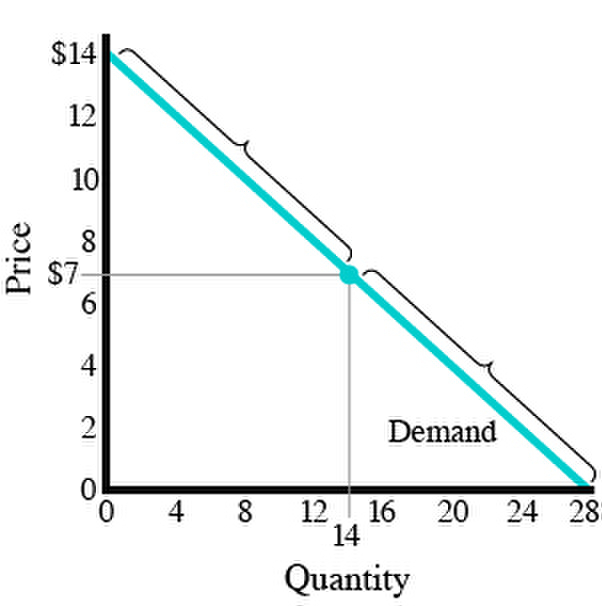ECON 1201 - Chapter 6
1/20
Earn XP
Description and Tags
Name | Mastery | Learn | Test | Matching | Spaced |
|---|
No study sessions yet.
21 Terms
If the cross elasticity of demand between cheese and yogurt is positive, then:
(A) the demand for cheese and the demand for yogurt are both price inelastic
(B) the demand for cheese and the demand for yogurt are both price elastic
(C) cheese and yogurt are complements
(D) cheese and yogurt are substitutes
(D) cheese and yogurt are substitutes
If the price elasticity of demand for basketball shoes is 4:
(A) a 20% decrease in the price of shoes will increase quantity demanded by 80%
(B) a 10% increase in the price of shoes will increase quantity demanded by 40%
(C) None of the other 3 possible answers listed here are correct
(D) a 20% increase in the price of shoes will increase quantity demanded by 80%
(A) a 20% decrease in the price of shoes will increase quantity demanded by 80%

The graph depicts five demand curves. Please rank each curve in terms of elasticity. A curve that is more elastic than another curve for any given quantity can be considered more elastic.
(A) D, A, E, C, B
(B) A, D, B, E, C
(C) C, E, B, D, A
(D) B, D, A, C, E
(C) C, E, B, D, A
If the income elasticity of electric cars is positive:
(A) electric cars are a normal good
(B) there are many substitutes for electric cars
(C) there are few substitutes for electric cars
(D) electric cars are an inferior good
(A) electric cars are a normal good
The price of matcha tea increases by 10%, and as a result, Cassandra purchases fewer biscotti. For Cassandra, matcha tea and biscotti are:
(A) inferior goods
(B) normal goods
(C) complements
(D) substitutes
(C) complements
It is very easy for Evelyn to find inexpensive inputs for her business. Evelyn's supply is therefore likely to be:
(A) inelastic
(B) elastic
(C) perfectly elastic
(D) unit-elastic
(B) elastic
A product that is a luxury, has many substitutes and is very expensive will tend to have an elasticity value that is:
(A) unitary
(B) very inelastic
(C) elastic
(D) inelastic
(C) elastic
Which statement best characterizes the relationship between the elasticity of demand, price, and total revenue?
(A) When demand is elastic and price falls, total revenue rises
(B) When demand is inelastic and price falls, total revenue rises
(C) When demand is elastic and price falls, total revenue falls
(D) When demand is inelastic and price falls, total revenue does not change
(A) When demand is elastic and price falls, total revenue rises

(Figure: The Demand for Winter Gloves) The price elasticity of demand over the segment DE, computed using the midpoint method, is:
(A) 1
(B) 0.29
(C) 0.71
(D) greater than 10
(C) 0.71
Which factor does NOT determine the price elasticity of demand?
(A) the slope of the supply curve
(B) the time available to adjust to price changes
(C) the number of available substitutes
(D) the proportion of the budget spent on the item
(A) the slope of the supply curve
What does price elasticity of supply measure?
(A) how responsive price is to a change in quantity demanded
(B) how responsive quantity supplied is to a change in price
(C) how responsive price is to a change in quantity supplied
(D) how responsive supply is to a change in price
(B) how responsive quantity supplied is to a change in price
If the price elasticity of supply for plastic is 0.67, then the price elasticity of supply for plastic is:
(A) unit elastic
(B) perfectly inelastic
(C) perfectly elastic
(D) relatively elastic
(E) relatively inelastic
(E) relatively inelastic
A product that is produced by a monopoly or near monopoly will tend to have a price elasticity of demand that is:
(A) elastic in nature
(B) unitary in nature
(C) inelastic in nature
(D) zero
(C) inelastic in nature

Graph A shows a demand curve that is:
(A) unit elastic
(B) elastic
(C) inelastic
(D) perfectly inelastic
(E) perfectly elastic
(E) perfectly elastic

Graph B shows a demand or supply curve that is:
(A) unit elastic
(B) elastic
(C) inelastic
(D) perfectly inelastic
(E) perfectly elastic
(D) perfectly inelastic

Graph C shows a demand curve that is:
(A) unit elastic
(B) elastic
(C) inelastic
(D) perfectly inelastic
(E) perfectly elastic
(A) unit elastic

Graph D shows a supply curve that is:
(A) unit elastic
(B) elastic
(C) inelastic
(D) perfectly inelastic
(E) perfectly elastic
(A) unit elastic

Graph E shows a demand curve that is ________ at the top, _______ at the point in the middle, and __________ at the bottom
(A) unit elastic; perfectly inelastic; elastic
(B) elastic; unit elastic; inelastic
(C) inelastic; unit elastic; elastic
(D) perfectly inelastic; inelastic; elastic
(E) perfectly elastic; elastic; inelastic
(B) elastic; unit elastic; inelastic

Graph F shows a demand curve that is:
(A) unit elastic
(B) elastic
(C) inelastic
(D) perfectly inelastic
(E) perfectly elastic
(E) perfectly elastic
A product that is a necessity, has few substitutes and is produced in a near monopoly market place will tend to have an elasticity value that is:
(A) elastic
(B) inelastic
(C) very highly elastic
(D) unitary
(B) inelastic
The state of Texas recently saw a gasoline price increase of 5%, which brought about a fall in the quantity of gasoline purchased of 1%. The price of elasticity of supply is equal to ______, and supply is described as ______.
(A) 0.2; elastic
(B) 5; elastic
(C) based on the information in the question it is impossible to answer this question
(D) 5; inelastic
(C) based on the information in the question it is impossible to answer this question